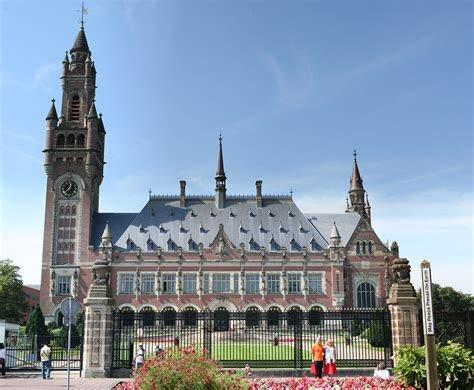This year, the Peace Palace, will celebrate its 100-year Anniversary. As official celebrations will commence in August, the Peace Palace Library starts with a series of library blogs in retrospect. The foundation of the Peace Palace in 1913 marked a pivotal point between two centuries. At the end of the 19th century, the idea of world peace was blooming as never before. At the dawn of the 20th century however, expectations had toned down considerably.
This year, the Peace Palace, will celebrate its 100-year Anniversary. As official celebrations will commence in August, the Peace Palace Library starts with a series of library blogs in retrospect. The foundation of the Peace Palace in 1913 marked a pivotal point between two centuries. At the end of the 19th century, the idea of world peace was blooming as never before. Europe and America had some hundred flourishing peace societes, some of them with a significant number of members. The international peace movement was led by high-profile writers and pacifists such as Leo Tolstoi, Bertha von Suttner and Jean de Bloch. A Swiss organisation, the Société de la Paix, introduced the word pacifism into the world.
At the dawn of the 20th century however, expectations had toned down considerably. European nations invested heavily in building professional armies and marine fleets. All experimented with the development of newer and faster weapons that could be used on a wider scale. From the years 1891 to 1919, a real arms race between Germany, France and Russia took place. Specifically, Germany's envy of Britain's superior navy resulted in a costly building competition of Dreadnought-class ships. Ironically, one year after the inauguration of the Peace Palace in 1913, World War I broke out.
The Tsar's Rescript
Against this backdrop, the Russian Tsar Nicholas II took a remarkable initiative. On 24 August 1898, at their weekly reception at the Foreign Office in St. Petersburg, the ambassadors and ministers of the major nations accredited to the Russian Court were presented a written statement to be forwarded to their respective governments. In it, the Tsar invited the governments to join an international conference on peace and disarmament. According to the Tsar, he thought it would be better for the prosperity and progress of mankind if governments sat down and talked and concluded agreements instead of being divided and hostile towards one another. Initially, his call met with a great deal of disbelieve and scepticism. After all, Nicholas II was one of the many European rulers who were building up their military power. And how noble and great-hearted were the motives really that prompted this autocratic despot and monarch, who never felt the pressure from constitution or parliament, to call for peace? It was only after the United States reacted positively that the Russian initiative gained momentum. At Russia’s request, The Hague was chosen as the venue for this first peace conference. Several reflections may have been taken into consideration. The Netherlands had the right profile. Dutch humanists and jurists like Erasmus, Grotius and Van Bynckershoek had stood at the cradle of international law and the Netherlands had always stayed relatively neutral in European conflicts. Furthermore, The Hague had proven to be a good host city for the 1893 and 1894 conferences of the Inter-Parliamentary Union and the Hague Conference on Private International Law. Friedrich Fromhold Martens, diplomat and jurist in service of the Russian Empire, had been very much pleased by the way the Dutch had organized the meetings. The kinship of the Dutch royal family to the Russian monarchy may conceivably have been of influence in the Tsar’s choice. Young Queen Wilhelmina offered to host the conference at her summer residence in The Hague, the Palace 'Huis ten Bosch', not far from the city centre.
Building a Home for Peace
The agenda of the 1899 Peace Conference included proposals like freezing military expenditure, banning the use of submarine torpedoes and the technique of throwing explosive missiles from balloons, as well as stopping the development of new weapons with an increased greater firing power. Last but not least was the idea to use the principles of good offices, mediation and arbitration in order to prevent or end future international disputes. The results of this first Peace Conference were astounding: a Hague Convention consisting of four main sections and three additional declarations with rules for curbing the arms race, the humanisation of the conduct of war and the creation of a Permanent Court of Arbitration, to be established at The Hague. This Court managed to resolve various conflicts in the first years of its existence. It proved powerless in preventing wars, yet it was capable of stimulating other great achievements. Between the first successful conference and the Second Hague Peace Conference, held eight years later, the hectic process of building a home for the Permanent Court of Arbitration, the Peace Palace, was beginning to take shape.
- Eyffinger, A.C.G.M., The 1899 Hague Peace Conference: 'The Parliament of Man, the Federation of the World', The Hague, Kluwer Law International, 1999.
- Eyffinger, A.C.G.M., The Peace Palace: Residence for Justice, Domicile of Learning, The Hague : Carnegie Foundation, 1988.
- Rosenne, S. (réd.), Les Conférences de la Paix de La Haye de 1899 et 1907 et l'Arbitrage international: Actes et documents, Bruxelles, Bruylant, 2007.
- Rosenne, S. (ed.), The Hague Peace Conferences of 1899 and 1907 and International Arbitration: Reports and Documents, The Hague, T.M.C. Asser Press, 2001.
